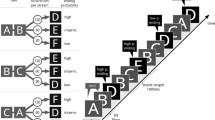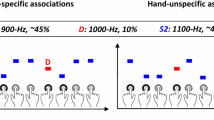Abstract
Predictive accounts of perception have received increasing attention in the past 20 years. Detecting violations of auditory regularities, as reflected by the Mismatch Negativity (MMN) auditory event-related potential, is amongst the phenomena seamlessly fitting this approach. Largely based on the MMN literature, we propose a psychological conceptual framework called the Auditory Event Representation System (AERS), which is based on the assumption that auditory regularity violation detection and the formation of auditory perceptual objects are based on the same predictive regularity representations. Based on this notion, a computational model of auditory stream segregation, called CHAINS, has been developed. In CHAINS, the auditory sensory event representation of each incoming sound is considered for being the continuation of likely combinations of the preceding sounds in the sequence, thus providing alternative interpretations of the auditory input. Detecting repeating patterns allows predicting upcoming sound events, thus providing a test and potential support for the corresponding interpretation. Alternative interpretations continuously compete for perceptual dominance. In this paper, we briefly describe AERS and deduce some general constraints from this conceptual model. We then go on to illustrate how these constraints are computationally specified in CHAINS.


Similar content being viewed by others
Notes
These correspond to auditory sensory memory representations of the classical MMN model (e.g. Näätänen 1990). We prefer the term auditory stimulus event representations as a stimulus event is represented.
References
Althen H, Grimm S, Escera C (2013) Simple and complex acoustic regularities are encoded at different levels of the auditory hierarchy. Eur J Neurosci 38(10):3448–3455
Baldeweg T (2007) ERP repetition effects and mismatch negativity generation—A predictive coding perspective. J Psychophysiol 21(3–4):204–213
Beauvois MW, Meddis R (1991) A computer-model of auditory stream segregation. Q J Exp Psychol Sect A 43(3):517–541
Bendixen A, Roeber U, Schröger E (2007) Regularity extraction and application in dynamic auditory stimulus sequences. J Cogn Neurosci 19(10):1664–1677
Bendixen A, Prinz WG, Horváth J, Trujillo-Barreto NJ, Schröger E (2008) Rapid extraction of auditory feature contingencies. Neuroimage 41(3):1111–1119
Bendixen A, Schröger E, Winkler I (2009) I heard that coming: event-related potential evidence for stimulus-driven prediction in the auditory system. J Neurosci 29(26):8447–8451
Bendixen A, Denham SL, Gyimesi K, Winkler I (2010) Regular patterns stabilize auditory streams. J Acoust Soc Am 128(6):3658–3666
Bendixen A, SanMiguel I, Schröger E (2012a) Early electrophysiological indicators for predictive processing in audition: a review. Int J Psychophysiol 83(2):120–131
Bendixen A, Schröger E, Ritter W, Winkler I (2012b) Regularity extraction from non-adjacent sounds. Frontiers Psychol 3:143
Bendixen A, Bőhm TM, Szalárdy O, Mill R, Denham SL, Winkler I (2013) Different roles of similarity and predictability in auditory stream segregation. Learn Percept 5:37–54
Boh B, Herholz SC, Lappe C, Pantev C (2011) Processing of complex auditory patterns in musicians and nonmusicians. PLoS One 6(7):e21458
Bregman AS (1990) Auditory scene analysis. The perceptual organization of sound. MIT PressMA, Cambridge
Costa-Faidella J, Grimm S, Slabu L, Diaz-Santaella F, Escera C (2011) Multiple time scales of adaptation in the auditory system as revealed by human evoked potentials. Psychophysiology 48(6):774–783
Cowan N (1984) On short and long auditory stores. Psychol Bull 96(2):341–370
Cowan N, Winkler I, Teder W, Näätänen R (1993) Memory prerequisites of mismatch negativity in the auditory event-related potential (ERP). J Exp Psychol-Learn Mem Cogn 19(4):909–921
Deike S, Heil P, Böckmann-Barthel M, Brechmann A (2012) The build-up of auditory stream segregation: a different perspective. Frontiers Psychol 3:461
Denham SL, Gyimesi K, Stefanics G, Winkler I (2013) Perceptual bistability in auditory streaming: how much do stimulus features matter? Learn Percept 5(2):73–100
Elhilali M, Shamma SA (2008) A cocktail party with a cortical twist: how cortical mechanisms contribute to sound segregation. J Acoust Soc Am 124(6):3751–3771
Escera C, Leung S, Grimm S (2013) Deviance detection based on regularity encoding along the auditory hierarchy: electrophysiological evidence in humans. Brain Topogr. doi:10.1007/s10548-013-0328-4
Fowler CA, Rosenblum LD (1990) Duplex perception—a comparison of monosyllables and slamming doors. J Exp Psychol-Hum Percep Perform 16(4):742–754
Friston K, Kiebel S (2009a) Cortical circuits for perceptual inference. Neural Netw 22(8):1093–1104
Friston K, Kiebel S (2009b) Predictive coding under the free-energy principle. Philos Trans R Soc Lond B 364(1521):1211–1221
Garrido MI, Kilner JM, Stephan KE, Friston KJ (2009) The mismatch negativity: a review of underlying mechanisms. Clin Neurophysiol 120(3):453–463
Griffiths TD, Warren JD (2004) Opinion: what is an auditory object? Nat Review Neurosci 5:887–892
Grimm S, Escera C (2012) Auditory deviance detection revisited: evidence for a hierarchical novelty system. Int J Psychophysiol 85(1):88–92
Grossberg S, Govindarajan KK, Wyse LL, Cohen MA (2004) ARTSTREAM: a neural network model of auditory scene analysis and source segregation. Neural Netw 17(4):511–536
Haenschel C, Vernon DJ, Dwivedi P, Gruzelier JH, Baldeweg T (2005) Event-related brain potential correlates of human auditory sensory memory-trace formation. J Neurosci 25(45):10494–10501
Helmholtz Hv (1867) Handbuch der physiologischen Optik. Allgemeine Encyklopädie der Physik, vol Bd 9. Voss, Leipzig
Herrmann CS, Munk MHJ, Engel AK (2004) Cognitive functions of gamma-band activity: memory match and utilization. Trends Cogn Sci 8(8):347–355
Horváth J, Czigler I, Sussman E, Winkler I (2001) Simultaneously active pre-attentive representations of local and global rules for sound sequences in the human brain. Cogn Brain Res 12(1):131–144
Horváth J, Winkler I, Bendixen A (2008) Do N1/MMN, P3a, and RON form a strongly coupled chain reflecting the three stages of auditory distraction? Biol Psychol 79(2):139–147
Jacobs AM, Grainger J (1994) Models of visual word recognition—sampling the state-of-the-art. J Exp Psychol-Hum Percep Perform 20(6):1311–1334
Jones MR (1976) Time, our lost dimension: toward a new theory of perception, attention, and memory. Psychol Rev 83(5):323–355
Kiebel SJ, von Kriegstein K, Daunizeau J, Friston KJ (2009) Recognizing sequences of sequences. PLoS Comput Biol 5(8):e1000464
Köhler W (1947) Gestalt psychology: an introduction to new concepts in modern psychology. Liveright Publishing, New York
Kubovy M, Van Valkenburg D (2001) Auditory and visual objects. Cognition 80:97–126
Lieder F, Daunizeau J, Garrido MI, Friston KJ, Stephan KE (2013) Modelling trial-by-trial changes in the mismatch negativity. PLoS Comput Biol 9(2):e1002911
Massaro DW (1972) Preperceptual images, processing time, and perceptual units in auditory perception. Psychol Rev 79:124–145
McCabe SL, Denham MJ (1997) A model of auditory streaming. J Acoust Soc Am 101(3):1611–1621
Mill R, Bőhm T, Bendixen A, Winkler I, Denham SL CHAINS—Competition and cooperation between fragmentary event predictors in a model of auditory scene analysis. In: Information Sciences and Systems (CISS), 2011, IEEE 45th Annual Conference on, Baltimore, pp 1–6, 2011
Mill RW, Bőhm TM, Bendixen A, Winkler I, Denham SL (2013) Modelling the emergence and dynamics of perceptual organisation in auditory streaming. PLoS Comput Biol 9(3):e1002925
Moore BCJ, Gockel H (2002) Factors influencing sequential stream segregation. Acta Acust United Acust 88(3):320–333
Moore BCJ, Gockel HE (2012) Properties of auditory stream formation. Philos Trans Royal Soc B 367(1591):919–931
Müller D, Widmann A, Schröger E (2005) Deviance-repetition effects as a function of stimulus feature, feature value variation, and timing: a mismatch negativity study. Biol Psychol 68(1):1–14
Mumford D (1992) On the computational architecture of the neocortex II. The role of cortico-cortical loops. Biol Cybern 66(3):241–251
Näätänen R (1990) The Role of attention in auditory information-processing as revealed by event-related potentials and other brain measures of cognitive function. Behav Brain Sci 13(2):201–232
Näätänen R, Winkler I (1999) The concept of auditory stimulus representation in cognitive neuroscience. Psychol Bull 125(6):826–859
Näätänen R, Gaillard A, Mäntysalo S (1978) Early selective-attention effect on evoked potential reinterpreted. Acta Psychol 42:313–329
Näätänen R, Kujala T, Winkler I (2011) Auditory processing that leads to conscious perception: a unique window to central auditory processing opened by the mismatch negativity and related responses. Psychophysiology 48(1):4–22
Neisser U (1967) Cognitive psychology. Appleton-Century-Crofts, New York
Paavilainen P, Arajärvi P, Takegata R (2007) Preattentive detection of nonsalient contingencies between auditory features. NeuroReport 18(2):159–163
Rao RPN, Ballard DH (1999) Predictive coding in the visual cortex: a functional interpretation of some extra-classical receptive-field effects. Nat Neurosci 2(1):79–87
Rensink RA (2000) Seeing, sensing, and scrutinizing. Vision Res 40(10–12):1469–1487
Rinne T, Särkkä A, Degerman A, Schröger E, Alho K (2006) Two separate mechanisms underlie auditory change detection and involuntary control of attention. Brain Res 1077:135–143
Ritter W, Sussman E, Molholm S (2000) Evidence that the mismatch negativity system works on the basis of objects. NeuroReport 11(1):61–63
Ritter W, De Sanctis P, Molholm S, Javitt DC, Foxe JJ (2006) Preattentively grouped tones do not elicit MMN with respect to each other. Psychophysiology 43(5):423–430
Schröger E (2007) Mismatch negativity - A microphone into auditory memory. J Psychophysiol 21(3–4):138–146
Schwartz JL, Grimault N, Hupé J-M, Moore BC, Pressnitzer D (2012) Multistability in perception: binding sensory modalities, an overview. Philos Trans R Soc Lond B 367(1591):896–905
Sokolov EN (1963) Higher nervous functions: the orienting reflex. Annu Rev Physiol 25:545–580
Sussman ES (2005) Integration and segregation in auditory scene analysis. J Acoust Soc Am 117(3 Pt 1):1285–1298
Sussman ES, Gumenyuk V (2005) Organization of sequential sounds in auditory memory. NeuroReport 16(13):1519–1523
Sussman ES, Horváth J, Winkler I, Orr M (2007) The role of attention in the formation of auditory streams. Perc Psychophys 69(1):136–152
Szalárdy O, Winkler I, Schröger E, Widmann A, Bendixen A (2013) Foreground-background discrimination indicated by event-related brain potentials in a new auditory multistability paradigm. Psychophysiology 12:1239–1250
van Noorden LPAS (1975) Temporal coherence in the perception of tone sequences. Technical University, Eindhoven
Wacongne C, Labyt E, van Wassenhove V, Bekinschtein T, Naccache L, Dehaene S (2011) Evidence for a hierarchy of predictions and prediction errors in human cortex. Proc Natl Acad Sci USA 108(51):20754–20759
Wacongne C, Changeux JP, Dehaene S (2012) A neuronal model of predictive coding accounting for the mismatch negativity. J Neurosci 32(11):3665–3678
Wang DL, Chang P (2008) An oscillatory correlation model of auditory streaming. Cogn Neurodyn 2(1):7–19
Winkler I (2007) Interpreting the mismatch negativity. J Psychophysiol 21(3–4):147–163
Winkler I, Czigler I (1998) Mismatch negativity: deviance detection or the maintenance of the ‘standard’. NeuroReport 9(17):3809–3813
Winkler I, Czigler I (2012) Evidence from auditory and visual event-related potential (ERP) studies of deviance detection (MMN and vMMN) linking predictive coding theories and perceptual object representations. Int J Psychophysiol 83(2):132–143
Winkler I, Karmos G, Näätänen R (1996) Adaptive modeling of the unattended acoustic environment reflected in the mismatch negativity event-related potential. Brain Res 742(1–2):239–252
Winkler I, Korzyukov O, Gumenyuk V, Cowan N, Linkenkaer-Hansen K, Ilmoniemi RJ, Alho K, Näätänen R (2002) Temporary and longer term retention of acoustic information. Psychophysiology 39(4):530–534
Winkler I, Takegata R, Sussman E (2005) Event-related brain potentials reveal multiple stages in the perceptual organization of sound. Cogn Brain Res 25(1):291–299
Winkler I, van Zuijen TL, Sussman E, Horváth J, Näätänen R (2006) Object representation in the human auditory system. Eur J Neurosci 24(2):625–634
Winkler I, Denham SL, Nelken I (2009) Modeling the auditory scene: predictive regularity representations and perceptual objects. Trends Cogn Sci 13(12):532–540
Winkler I, Denham S, Mill R, Bőhm TM, Bendixen A (2012) Multistability in auditory stream segregation: a predictive coding view. Philos Trans Royal Soc B 367(1591):1001–1012
Acknowledgments
This research was supported by the Hungarian Academy of Sciences (Lendület project, LP2012-36/2012 to IW), by the Reinhart Koselleck grant of the German Research Foundation (Deutsche Forschungsgemeinschaft, DFG, SCH 375/20-1 to ES), by the DFG Cluster of Excellence 1077 “Hearing4all”, by the German Academic Exchange Service (Deutscher Akademischer Austauschdient, DAAD, Project 56265741), and by the Hungarian Scholarship Board (Magyar Ösztöndíj Bizottság, MÖB, Project 39589).
Author information
Authors and Affiliations
Corresponding author
Additional information
This is one of several papers published together in Brain Topography in the “Special Issue: Mismatch Negativity”.
Rights and permissions
About this article
Cite this article
Schröger, E., Bendixen, A., Denham, S.L. et al. Predictive Regularity Representations in Violation Detection and Auditory Stream Segregation: From Conceptual to Computational Models. Brain Topogr 27, 565–577 (2014). https://doi.org/10.1007/s10548-013-0334-6
Received:
Accepted:
Published:
Issue Date:
DOI: https://doi.org/10.1007/s10548-013-0334-6




